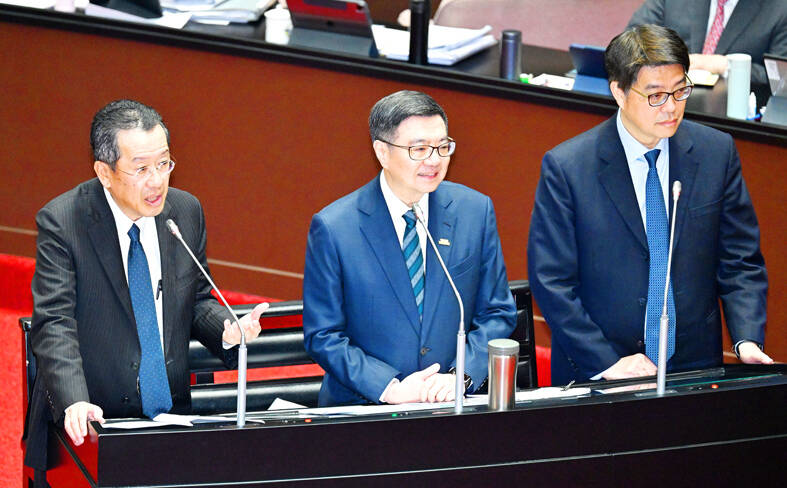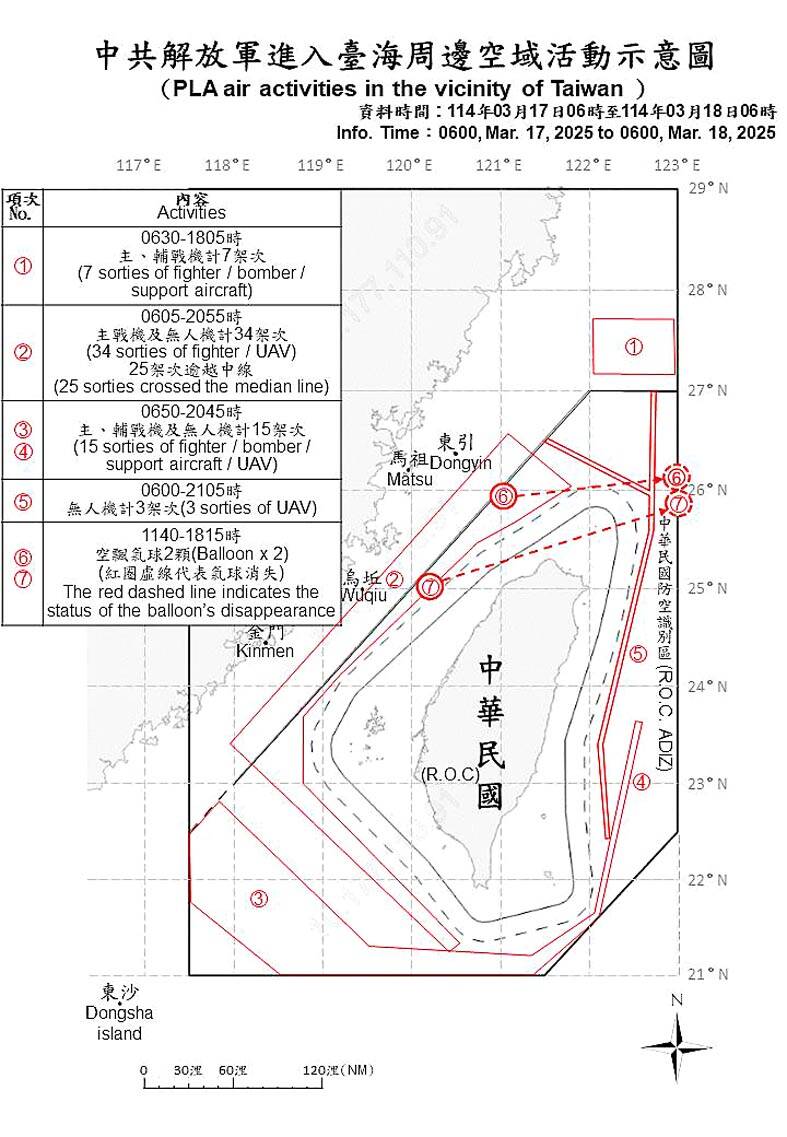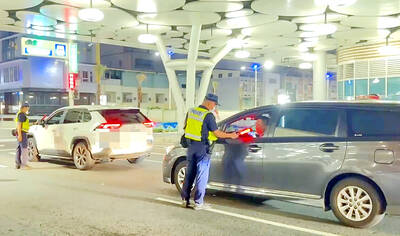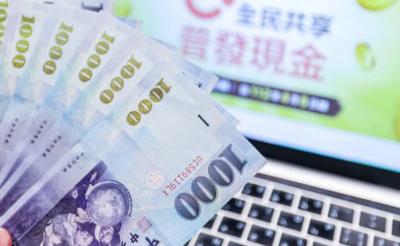China’s provocations of Taiwan using “gray zone” tactics and military exercises have intensified regional tensions and shown that Beijing is the “troublemaker” threatening peace and stability in the Taiwan Strait, officials said yesterday.
Minister of National Defense Wellington Koo (顧立雄) and Mainland Affairs Council Minister Chiu Chui-cheng (邱垂正) made the comments a day after China launched what Beijing called “joint combat readiness patrols.”
The “troublemaker” description follows President William Lai’s (賴清德) recent public remarks in which he designated China as a “foreign adversary.” Beijing has previously called Taiwan a “troublemaker” in cross-strait relations.

Photo: Liao Chen-huei, Taipei Times
China’s Taiwan Affairs Office on Monday described the movements of Chinese aircraft and ships as “military exercises” in response to what it said is Lai promoting Taiwanese independence and separatism, and because of foreign interference.
The relatively large-scale patrols included more than two dozen Chinese military aircraft crossing the median line of the Taiwan Strait and dozens more flying into Taiwan’s air defense identification zone (ADIZ) in collaboration with Chinese naval vessels.
Asked to distinguish between “joint combat readiness patrol” and a “military exercise,” Koo said the “patrols” are usually conducted by the Chinese People’s Liberation Army (PLA) on a weekly basis and involve “more PLA Air Force and Navy assets, and Chinese naval vessels advance to 24 nautical miles [44km] off Taiwan’s coast.”

Photo courtesy of the Ministry of National Defense
China conducted two joint combat readiness patrols on Monday, as it has resorted to any excuses it could find to justify its actions, Koo said.
The Chinese Ministry of Foreign Affairs offered a different interpretation of the military patrols.
Chinese Ministry of Foreign Affairs spokeswoman Mao Ning (毛寧) said the patrols were in response to “the US State Department’s alteration of documents on US-Taiwan relations” that endangered peace across the Strait.
Mao was apparently referring to the department’s change of a Taiwan-US relations fact sheet published on its Web site in the middle of last month. It removed a line indicating Washington’s long-held stance of not supporting Taiwanese independence.
In a statement issued late on Monday, the Ministry of Foreign Affairs “strongly condemned” China’s military action that it said jeopardized cross-strait peace and stability.
Separately yesterday, the Ministry of National Defense said China deployed 59 warplanes and nine vessels in Taiwan’s vicinity on Monday after a few days of relative calm.
Of those aircraft, more than two dozen crossed the median line of the Taiwan Strait and the others entered Taiwan’s ADIZ, a flight map released by the ministry showed.
Two balloons were also detected over waters just north of Taiwan between 6am Monday and 6am yesterday.
The ministry said it scrambled combat air and sea patrols, and deployed defense missile systems to track the Chinese military aircraft.
The ministry yesterday released footage of Taiwanese naval vessels monitoring the Chinese military ships operating around Taiwan, including a Keelung-class destroyer (formerly a Kidd-class destroyer) watching China’s Type 052D destroyer the Guilin.
It also showed surveillance photographs of Chinese attack drones and uncrewed aerial vehicles taken by a Taiwan air force F-16V jet and navy P-3C anti-submarine aircraft.

TRAFFIC SAFETY RULES: A positive result in a drug test would result in a two-year license suspension for the driver and vehicle, and a fine of up to NT$180,000 The Ministry of Transportation and Communications is to authorize police to conduct roadside saliva tests by the end of the year to deter people from driving while under the influence of narcotics, it said yesterday. The ministry last month unveiled a draft of amended regulations governing traffic safety rules and penalties, which included provisions empowering police to conduct mandatory saliva tests on drivers. While currently rules authorize police to use oral fluid testing kits for signs of drug use, they do not establish penalties for noncompliance or operating procedures for officers to follow, the ministry said. The proposed changes to the regulations require

The Executive Yuan yesterday announced that registration for a one-time universal NT$10,000 cash handout to help people in Taiwan survive US tariffs and inflation would start on Nov. 5, with payouts available as early as Nov. 12. Who is eligible for the handout? Registered Taiwanese nationals are eligible, including those born in Taiwan before April 30 next year with a birth certificate. Non-registered nationals with residence permits, foreign permanent residents and foreign spouses of Taiwanese citizens with residence permits also qualify for the handouts. For people who meet the eligibility requirements, but passed away between yesterday and April 30 next year, surviving family members

China Airlines Ltd (CAL) yesterday morning joined SkyTeam’s Aviation Challenge for the fourth time, operating a demonstration flight for “net zero carbon emissions” from Taiwan Taoyuan International Airport to Bangkok. The flight used sustainable aviation fuel (SAF) at a ratio of up to 40 percent, the highest proportion CAL has achieved to date, the nation’s largest carrier said. Since April, SAF has become available to Taiwanese international carriers at Taipei International Airport (Songshan airport), Kaohsiung International Airport and Taoyuan airport. In previous challenges, CAL operated “net zero carbon emission flights” to Singapore and Japan. At a ceremony at Taoyuan airport, China Airlines chief sustainability

‘ONE CHINA’: A statement that Berlin decides its own China policy did not seem to sit well with Beijing, which offered only one meeting with the German official German Minister for Foreign Affairs Johann Wadephul’s trip to China has been canceled, a spokesperson for his ministry said yesterday, amid rising tensions between the two nations, including over Taiwan. Wadephul had planned to address Chinese curbs on rare earths during his visit, but his comments about Berlin deciding on the “design” of its “one China” policy ahead of the trip appear to have rankled China. Asked about Wadephul’s comments, Chinese Ministry of Foreign Affairs spokesman Guo Jiakun (郭嘉昆) said the “one China principle” has “no room for any self-definition.” In the interview published on Thursday, Wadephul said he would urge China to